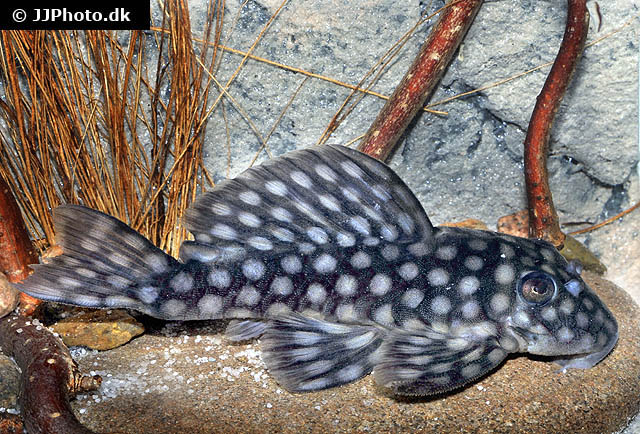| Loricariidae (Armored catfishes), subfamily: Hypostominae |
| 24 cm TL (male/unsexed); max.weight: 220.0 g |
|
demersal; freshwater |
| South America: Rio Xingu basin in Pará State, Brazil. |
|
Dorsal soft rays (total): 8-8; Anal soft rays: 5-5; Vertebrae: 26-26. This is distinguished from other species of Spectracanthicus by its color pattern consisting of large, white spots (vs. small yellowish dots in S. murinus, S. punctatissimus, and S. tocantinensis , and dark gray lacking dots in S. immaculatus). It also differs from congeners, except S. murinus, by having larger orbital diameter up to 29.2% of HL (vs. up to 25.7% in S. punctatissimus, 20.3% in S. tocantinensis, 16.2% in S. immaculatus). It can be further separated from S. murinus by having rounded dorsal view of the snout, bar-shaped, eversible opercle with conspicuous odontodes, and four unbranched anal-fin rays (vs. snout slightly pointed; opercle triangle-shaped, not eversible, lacking conspicuous odontodes; three anal-fin unbranched rays); from S. tocantinensis by having 19-43 dentary teeth (vs. 8-16) and by the infraorbital 4 forming just a small area of orbit (vs. forming posterior edge of orbit almost totally) (Ref. 95496).
Description: Dorsal-fin rays i,7; anal-fin rays i,4; pectoral-fin rays i,6; pelvic-fin rays i,5; dorsal-fin spinelet V-shaped with locking mechanism; dorsal-fin base very long, its length equivalent to 12 dorsal plates, reaching pre-adipose plate and connected to adipose fin by thick membrane.(Ref. 95496). |
| Feeds actively at night on algae and other food items off periphyton by grazing over rock bottom. Found in rock-bottom areas subjected to backwater and strong currents. Occurs individually or in groups of three, under shelter boulders (adults) and spaces beneath rocks (juveniles), up to 2m deep. Juveniles co-inhabit with other loricariids such as Ancistrus sp., A. ranunculus, Baryancistrus xanthellus, Spectracanthicus punctatissimus , Hopliancistrus tricornis, Parancistrus nudiventris, Peckoltia vittata, and Pseudancistrus aff. barbatus (Ref. 95496). |
|
Not Evaluated (N.E.) Ref. (130435)
|
| harmless |
Source and more info: www.fishbase.org. For personal, classroom, and other internal use only. Not for publication.
